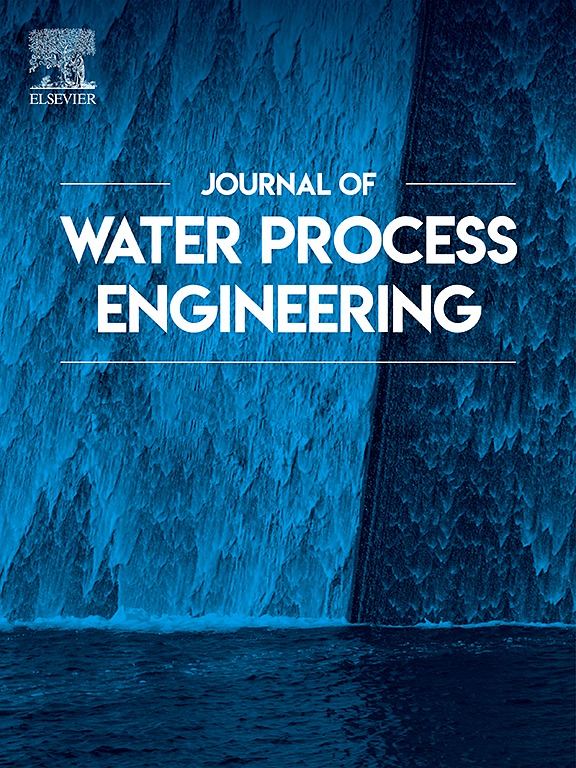Stacked-based hybrid gradient boosting models for estimating seepage from lined canals
IF 6.3
2区 工程技术
Q1 ENGINEERING, CHEMICAL
引用次数: 0
Abstract
Accurate seepage loss estimation from lined canals is crucial for effective water management, especially in water-scarce regions. This study explores seepage loss prediction using advanced gradient boosting models optimized through Bayesian optimization (BO) and introduces a novel Stacked Multiple Linear Regression (SM-MLR) approach. Four hybrid base models were evaluated: Extreme Gradient Boosting (XGB), Light Gradient Boosting Machine (LGB), CatBoost Gradient Boosting (CGB), and Natural Gradient Boosting (NGB), alongside SM-MLR. A dataset of 600 records, using key canal and liner characteristics as inputs, was analyzed. Model performance was assessed using R2 and RMSE, with uncertainty evaluations and feature analysis through Partial Dependence Plots (PDPs) and SHapley Additive exPlanations (SHAP). Results showed that the SM-MLR model achieved the highest predictive accuracy, with an R2 of 0.998 and RMSE of 0.161 during testing, significantly outperforming all base models and setting a new benchmark for seepage loss prediction in lined canals. Among the base models, BO-CGB demonstrated strong and consistent performance, but it slightly lagged behind the SM-MLR model in terms of overall accuracy. SHAP and PDP analysis identified liner hydraulic conductivity (kL) as the most influential factor in seepage loss, followed by canal geometry and liner thickness. Further insights were gained from sensitivity analysis, which validated that optimizing kL is the most effective strategy for minimizing seepage. Thus, the potential of hybrid ensemble modeling was highlighted in significantly improving predictive accuracy, providing a robust and reliable tool for water resource management. The SM-MLR model, by outperforming previous best predictive models, offers actionable insights for real-world canal design, emphasizing the need to consider both hydraulic and geometric parameters to optimize canal performance and support water conservation efforts in water-scarce regions.

求助全文
约1分钟内获得全文
求助全文
来源期刊

Journal of water process engineering
Biochemistry, Genetics and Molecular Biology-Biotechnology
CiteScore
10.70
自引率
8.60%
发文量
846
审稿时长
24 days
期刊介绍:
The Journal of Water Process Engineering aims to publish refereed, high-quality research papers with significant novelty and impact in all areas of the engineering of water and wastewater processing . Papers on advanced and novel treatment processes and technologies are particularly welcome. The Journal considers papers in areas such as nanotechnology and biotechnology applications in water, novel oxidation and separation processes, membrane processes (except those for desalination) , catalytic processes for the removal of water contaminants, sustainable processes, water reuse and recycling, water use and wastewater minimization, integrated/hybrid technology, process modeling of water treatment and novel treatment processes. Submissions on the subject of adsorbents, including standard measurements of adsorption kinetics and equilibrium will only be considered if there is a genuine case for novelty and contribution, for example highly novel, sustainable adsorbents and their use: papers on activated carbon-type materials derived from natural matter, or surfactant-modified clays and related minerals, would not fulfil this criterion. The Journal particularly welcomes contributions involving environmentally, economically and socially sustainable technology for water treatment, including those which are energy-efficient, with minimal or no chemical consumption, and capable of water recycling and reuse that minimizes the direct disposal of wastewater to the aquatic environment. Papers that describe novel ideas for solving issues related to water quality and availability are also welcome, as are those that show the transfer of techniques from other disciplines. The Journal will consider papers dealing with processes for various water matrices including drinking water (except desalination), domestic, urban and industrial wastewaters, in addition to their residues. It is expected that the journal will be of particular relevance to chemical and process engineers working in the field. The Journal welcomes Full Text papers, Short Communications, State-of-the-Art Reviews and Letters to Editors and Case Studies
 求助内容:
求助内容: 应助结果提醒方式:
应助结果提醒方式:


